jump start CHEVROLET MONTE CARLO 2004 Owners Manual
[x] Cancel search | Manufacturer: CHEVROLET, Model Year: 2004, Model line: MONTE CARLO, Model: CHEVROLET MONTE CARLO 2004Pages: 416, PDF Size: 4.56 MB
Page 257 of 416
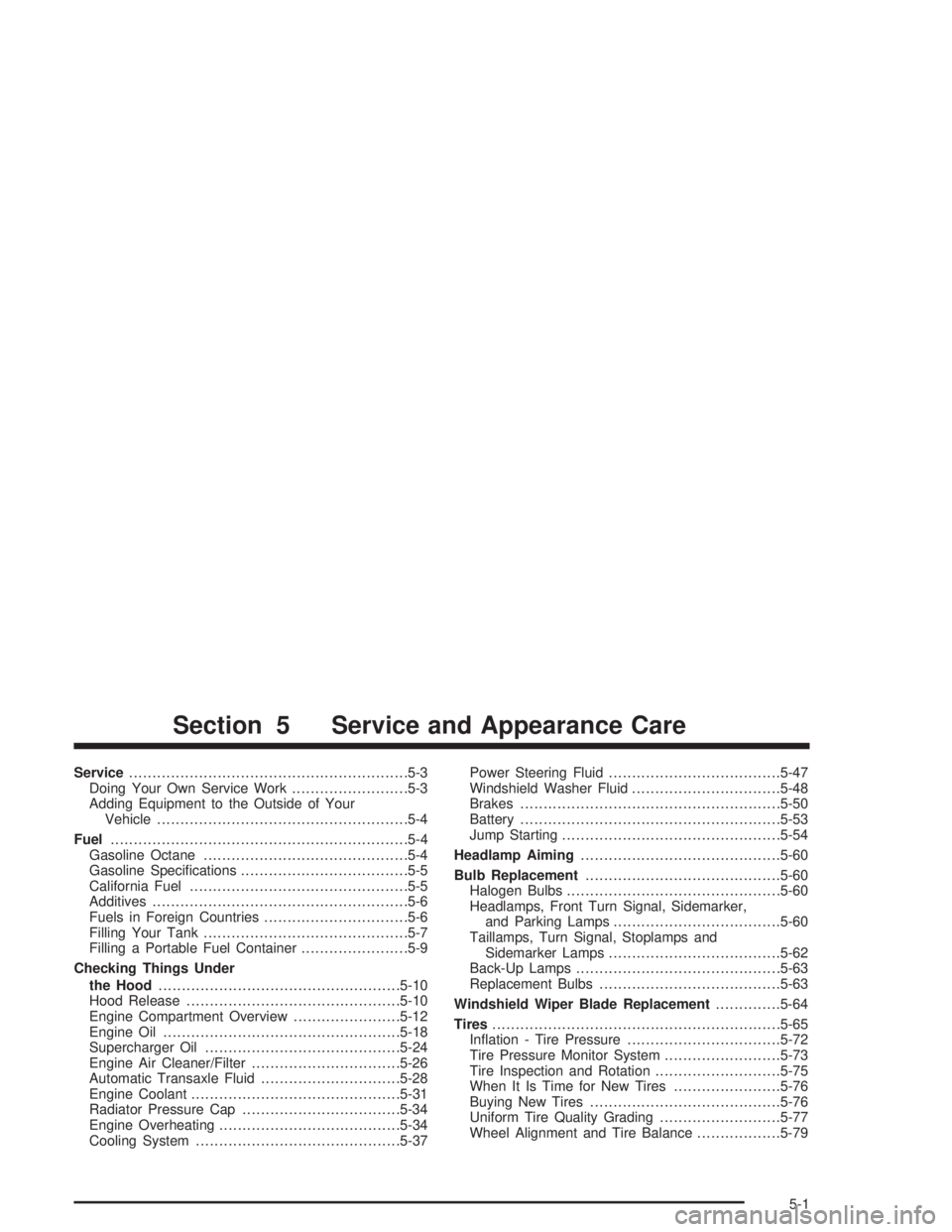
Service............................................................5-3
Doing Your Own Service Work.........................5-3
Adding Equipment to the Outside of Your
Vehicle......................................................5-4
Fuel................................................................5-4
Gasoline Octane............................................5-4
Gasoline Speci�cations....................................5-5
California Fuel...............................................5-5
Additives.......................................................5-6
Fuels in Foreign Countries...............................5-6
Filling Your Tank............................................5-7
Filling a Portable Fuel Container.......................5-9
Checking Things Under
the Hood....................................................5-10
Hood Release..............................................5-10
Engine Compartment Overview.......................5-12
Engine Oil...................................................5-18
Supercharger Oil..........................................5-24
Engine Air Cleaner/Filter................................5-26
Automatic Transaxle Fluid..............................5-28
Engine Coolant.............................................5-31
Radiator Pressure Cap..................................5-34
Engine Overheating.......................................5-34
Cooling System............................................5-37Power Steering Fluid.....................................5-47
Windshield Washer Fluid................................5-48
Brakes........................................................5-50
Battery........................................................5-53
Jump Starting...............................................5-54
Headlamp Aiming...........................................5-60
Bulb Replacement..........................................5-60
Halogen Bulbs..............................................5-60
Headlamps, Front Turn Signal, Sidemarker,
and Parking Lamps....................................5-60
Taillamps, Turn Signal, Stoplamps and
Sidemarker Lamps.....................................5-62
Back-Up Lamps............................................5-63
Replacement Bulbs.......................................5-63
Windshield Wiper Blade Replacement..............5-64
Tires..............................................................5-65
In�ation - Tire Pressure.................................5-72
Tire Pressure Monitor System.........................5-73
Tire Inspection and Rotation...........................5-75
When It Is Time for New Tires.......................5-76
Buying New Tires.........................................5-76
Uniform Tire Quality Grading..........................5-77
Wheel Alignment and Tire Balance..................5-79
Section 5 Service and Appearance Care
5-1
Page 269 of 416
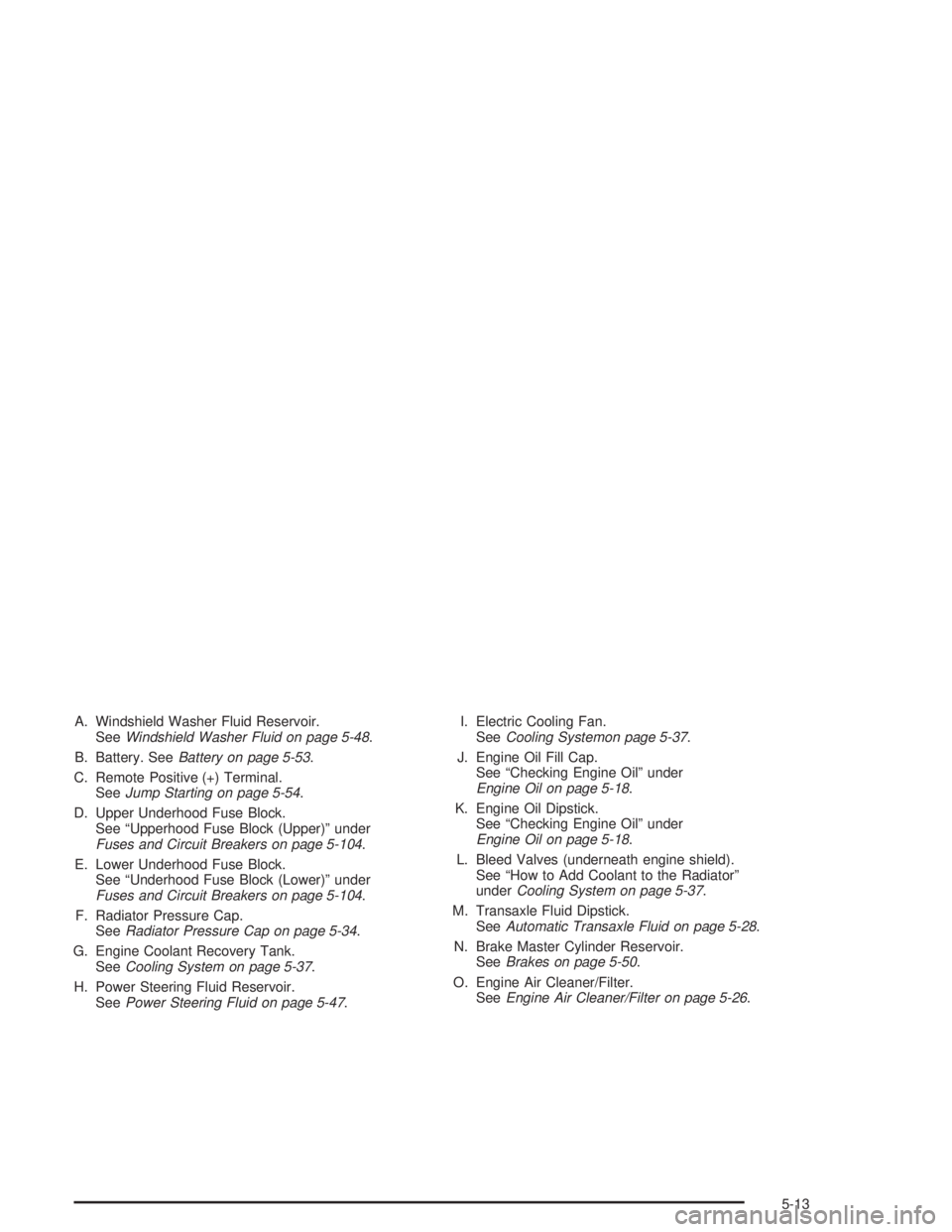
A. Windshield Washer Fluid Reservoir.
SeeWindshield Washer Fluid on page 5-48.
B. Battery. SeeBattery on page 5-53.
C. Remote Positive (+) Terminal.
SeeJump Starting on page 5-54.
D. Upper Underhood Fuse Block.
See “Upperhood Fuse Block (Upper)” under
Fuses and Circuit Breakers on page 5-104.
E. Lower Underhood Fuse Block.
See “Underhood Fuse Block (Lower)” under
Fuses and Circuit Breakers on page 5-104.
F. Radiator Pressure Cap.
SeeRadiator Pressure Cap on page 5-34.
G. Engine Coolant Recovery Tank.
SeeCooling System on page 5-37.
H. Power Steering Fluid Reservoir.
SeePower Steering Fluid on page 5-47.I. Electric Cooling Fan.
SeeCooling Systemon page 5-37.
J. Engine Oil Fill Cap.
See “Checking Engine Oil” under
Engine Oil on page 5-18.
K. Engine Oil Dipstick.
See “Checking Engine Oil” under
Engine Oil on page 5-18.
L. Bleed Valves (underneath engine shield).
See “How to Add Coolant to the Radiator”
underCooling System on page 5-37.
M. Transaxle Fluid Dipstick.
SeeAutomatic Transaxle Fluid on page 5-28.
N. Brake Master Cylinder Reservoir.
SeeBrakes on page 5-50.
O. Engine Air Cleaner/Filter.
SeeEngine Air Cleaner/Filter on page 5-26.
5-13
Page 271 of 416
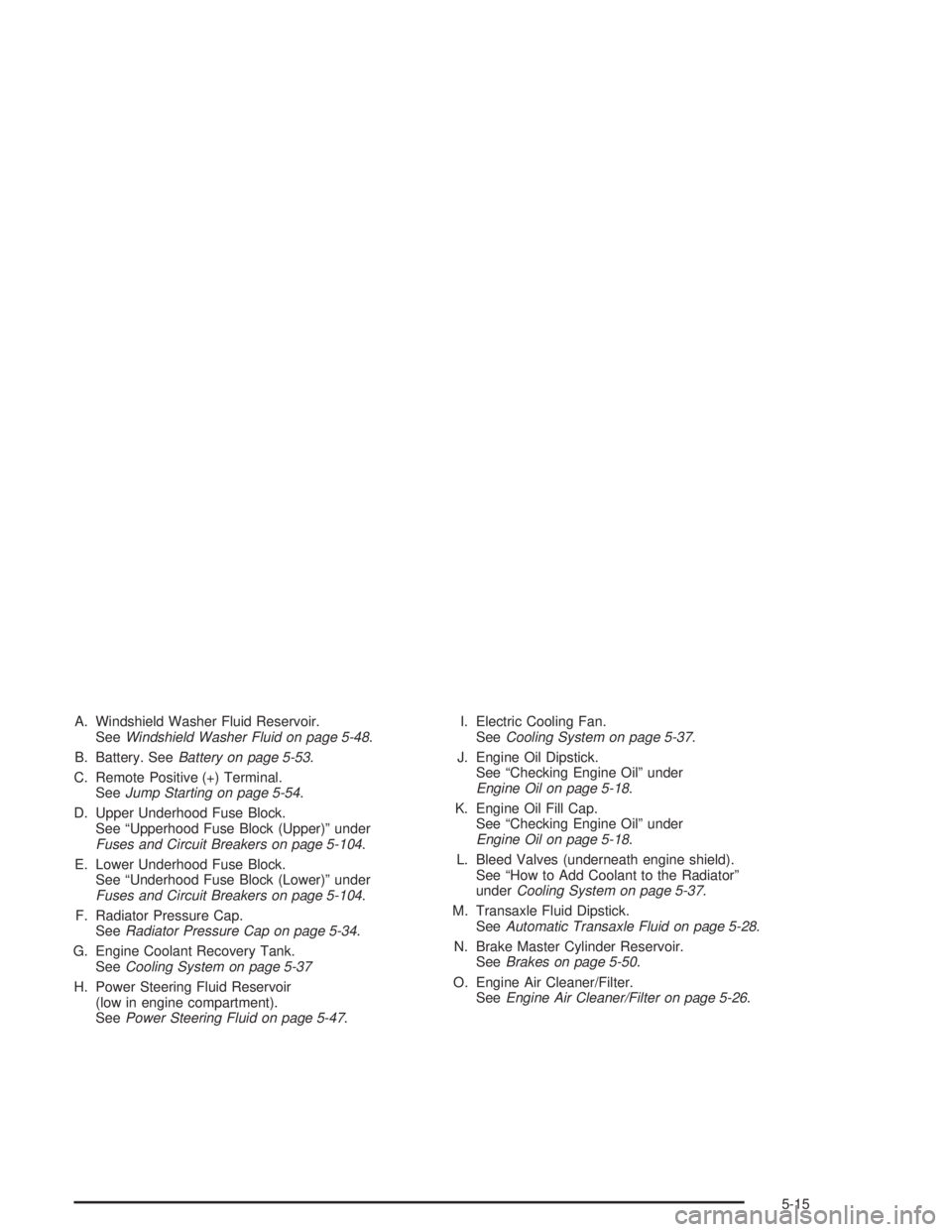
A. Windshield Washer Fluid Reservoir.
SeeWindshield Washer Fluid on page 5-48.
B. Battery. SeeBattery on page 5-53.
C. Remote Positive (+) Terminal.
SeeJump Starting on page 5-54.
D. Upper Underhood Fuse Block.
See “Upperhood Fuse Block (Upper)” under
Fuses and Circuit Breakers on page 5-104.
E. Lower Underhood Fuse Block.
See “Underhood Fuse Block (Lower)” under
Fuses and Circuit Breakers on page 5-104.
F. Radiator Pressure Cap.
SeeRadiator Pressure Cap on page 5-34.
G. Engine Coolant Recovery Tank.
SeeCooling System on page 5-37
H. Power Steering Fluid Reservoir
(low in engine compartment).
SeePower Steering Fluid on page 5-47.I. Electric Cooling Fan.
SeeCooling System on page 5-37.
J. Engine Oil Dipstick.
See “Checking Engine Oil” under
Engine Oil on page 5-18.
K. Engine Oil Fill Cap.
See “Checking Engine Oil” under
Engine Oil on page 5-18.
L. Bleed Valves (underneath engine shield).
See “How to Add Coolant to the Radiator”
underCooling System on page 5-37.
M. Transaxle Fluid Dipstick.
SeeAutomatic Transaxle Fluid on page 5-28.
N. Brake Master Cylinder Reservoir.
SeeBrakes on page 5-50.
O. Engine Air Cleaner/Filter.
SeeEngine Air Cleaner/Filter on page 5-26.
5-15
Page 309 of 416
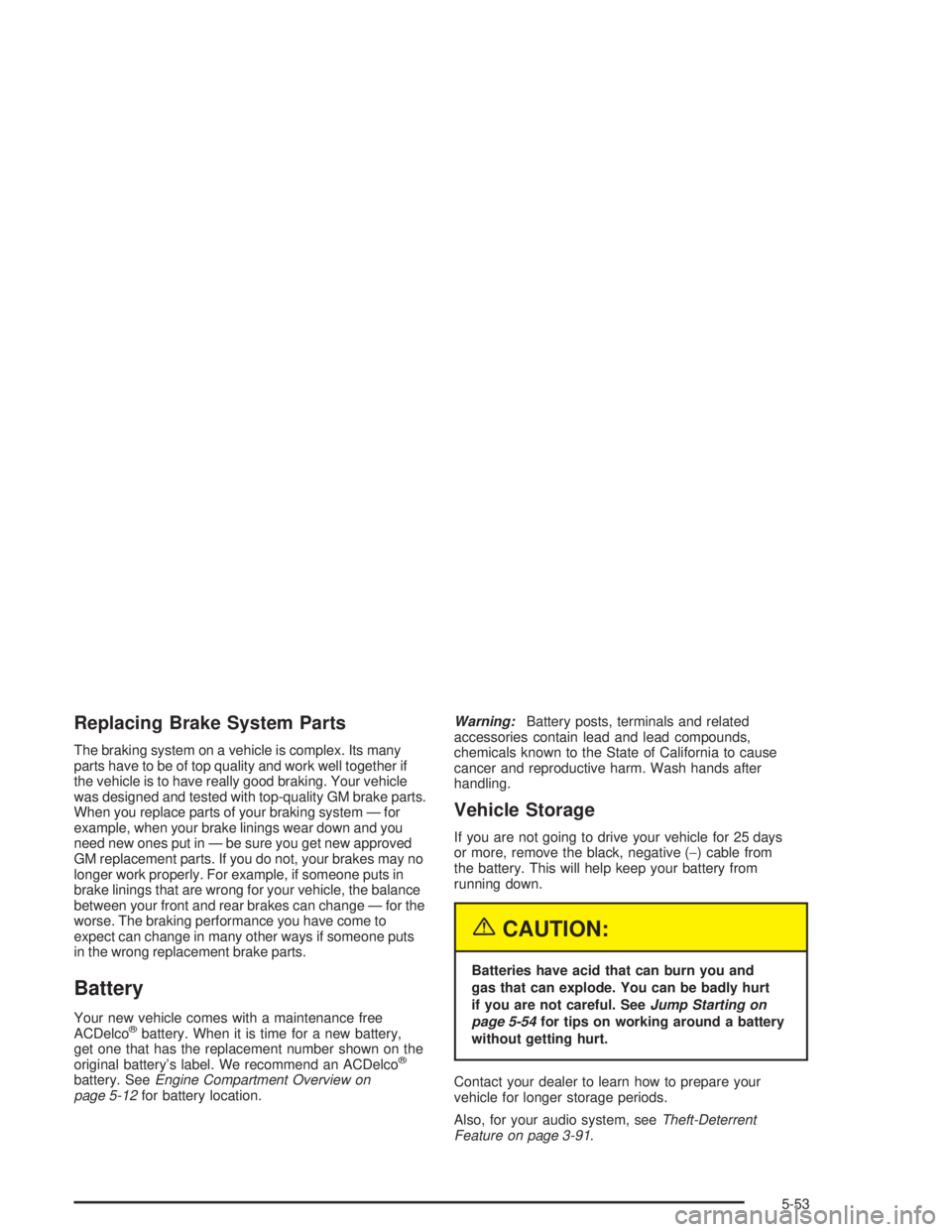
Replacing Brake System Parts
The braking system on a vehicle is complex. Its many
parts have to be of top quality and work well together if
the vehicle is to have really good braking. Your vehicle
was designed and tested with top-quality GM brake parts.
When you replace parts of your braking system — for
example, when your brake linings wear down and you
need new ones put in — be sure you get new approved
GM replacement parts. If you do not, your brakes may no
longer work properly. For example, if someone puts in
brake linings that are wrong for your vehicle, the balance
between your front and rear brakes can change — for the
worse. The braking performance you have come to
expect can change in many other ways if someone puts
in the wrong replacement brake parts.
Battery
Your new vehicle comes with a maintenance free
ACDelco®battery. When it is time for a new battery,
get one that has the replacement number shown on the
original battery’s label. We recommend an ACDelco
®
battery. SeeEngine Compartment Overview on
page 5-12for battery location.Warning:Battery posts, terminals and related
accessories contain lead and lead compounds,
chemicals known to the State of California to cause
cancer and reproductive harm. Wash hands after
handling.
Vehicle Storage
If you are not going to drive your vehicle for 25 days
or more, remove the black, negative (−) cable from
the battery. This will help keep your battery from
running down.
{CAUTION:
Batteries have acid that can burn you and
gas that can explode. You can be badly hurt
if you are not careful. SeeJump Starting on
page 5-54for tips on working around a battery
without getting hurt.
Contact your dealer to learn how to prepare your
vehicle for longer storage periods.
Also, for your audio system, seeTheft-Deterrent
Feature on page 3-91.
5-53
Page 310 of 416
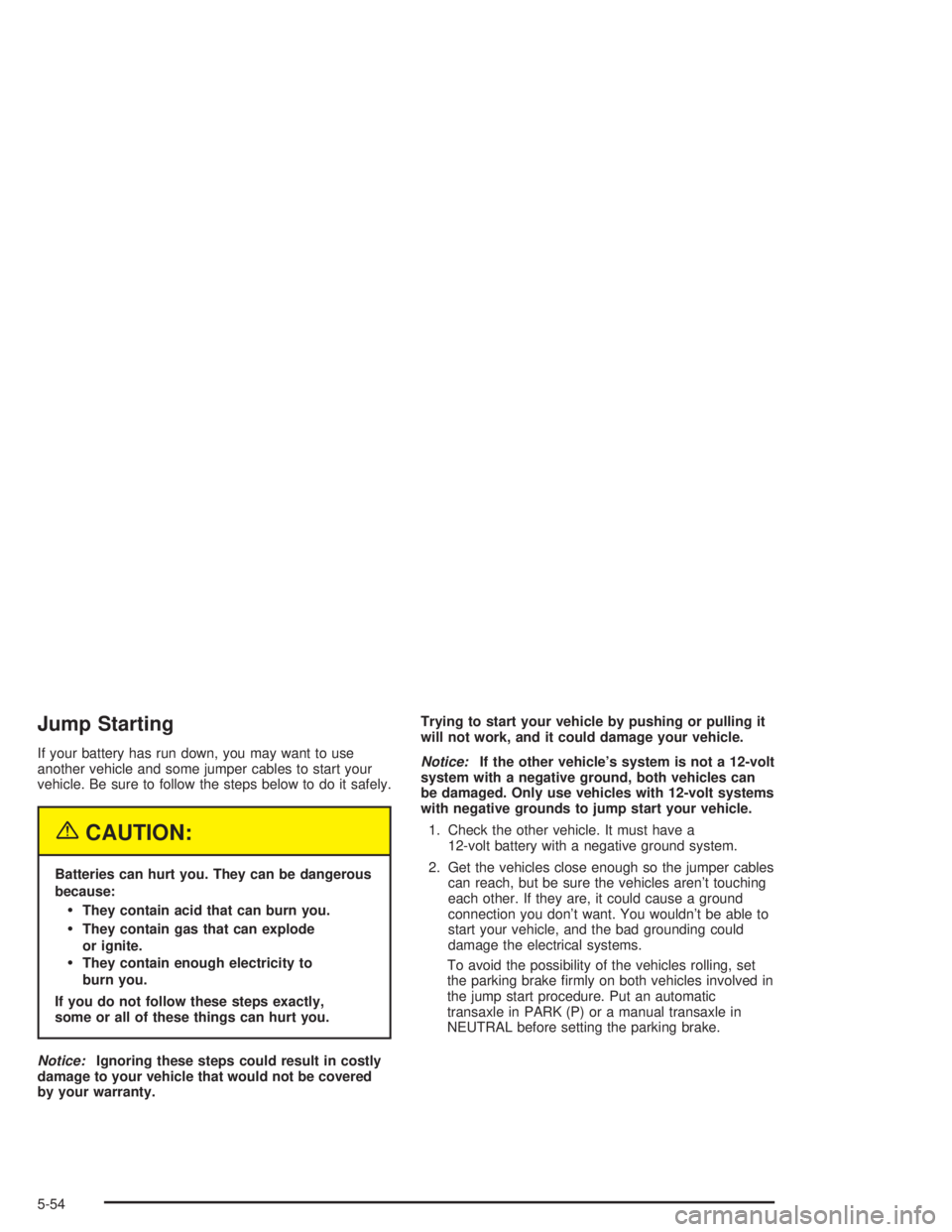
Jump Starting
If your battery has run down, you may want to use
another vehicle and some jumper cables to start your
vehicle. Be sure to follow the steps below to do it safely.
{CAUTION:
Batteries can hurt you. They can be dangerous
because:
They contain acid that can burn you.
They contain gas that can explode
or ignite.
They contain enough electricity to
burn you.
If you do not follow these steps exactly,
some or all of these things can hurt you.
Notice:Ignoring these steps could result in costly
damage to your vehicle that would not be covered
by your warranty.Trying to start your vehicle by pushing or pulling it
will not work, and it could damage your vehicle.
Notice:If the other vehicle’s system is not a 12-volt
system with a negative ground, both vehicles can
be damaged. Only use vehicles with 12-volt systems
with negative grounds to jump start your vehicle.
1. Check the other vehicle. It must have a
12-volt battery with a negative ground system.
2. Get the vehicles close enough so the jumper cables
can reach, but be sure the vehicles aren’t touching
each other. If they are, it could cause a ground
connection you don’t want. You wouldn’t be able to
start your vehicle, and the bad grounding could
damage the electrical systems.
To avoid the possibility of the vehicles rolling, set
the parking brake �rmly on both vehicles involved in
the jump start procedure. Put an automatic
transaxle in PARK (P) or a manual transaxle in
NEUTRAL before setting the parking brake.
5-54
Page 311 of 416
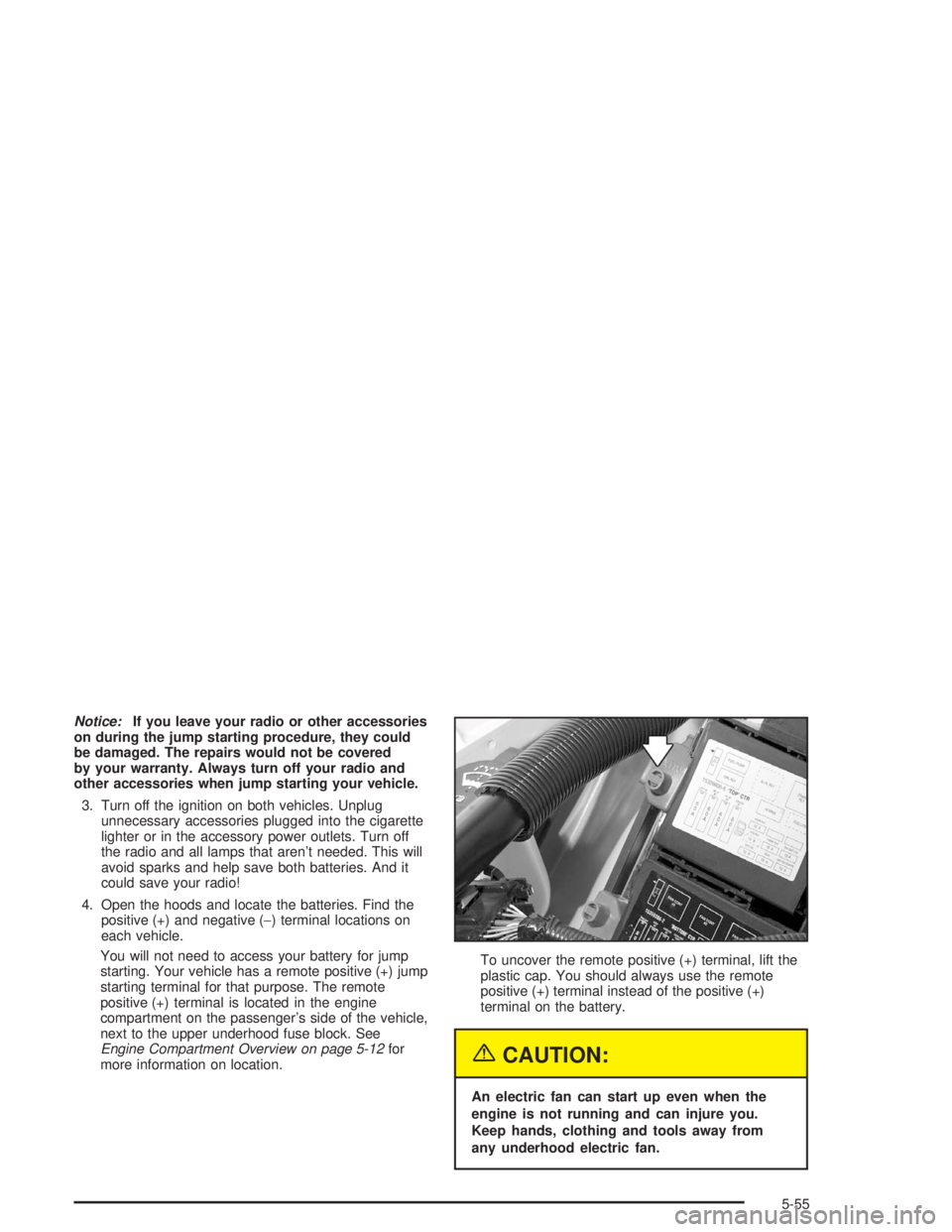
Notice:If you leave your radio or other accessories
on during the jump starting procedure, they could
be damaged. The repairs would not be covered
by your warranty. Always turn off your radio and
other accessories when jump starting your vehicle.
3. Turn off the ignition on both vehicles. Unplug
unnecessary accessories plugged into the cigarette
lighter or in the accessory power outlets. Turn off
the radio and all lamps that aren’t needed. This will
avoid sparks and help save both batteries. And it
could save your radio!
4. Open the hoods and locate the batteries. Find the
positive (+) and negative (−) terminal locations on
each vehicle.
You will not need to access your battery for jump
starting. Your vehicle has a remote positive (+) jump
starting terminal for that purpose. The remote
positive (+) terminal is located in the engine
compartment on the passenger’s side of the vehicle,
next to the upper underhood fuse block. See
Engine Compartment Overview on page 5-12for
more information on location.To uncover the remote positive (+) terminal, lift the
plastic cap. You should always use the remote
positive (+) terminal instead of the positive (+)
terminal on the battery.
{CAUTION:
An electric fan can start up even when the
engine is not running and can injure you.
Keep hands, clothing and tools away from
any underhood electric fan.
5-55
Page 393 of 416
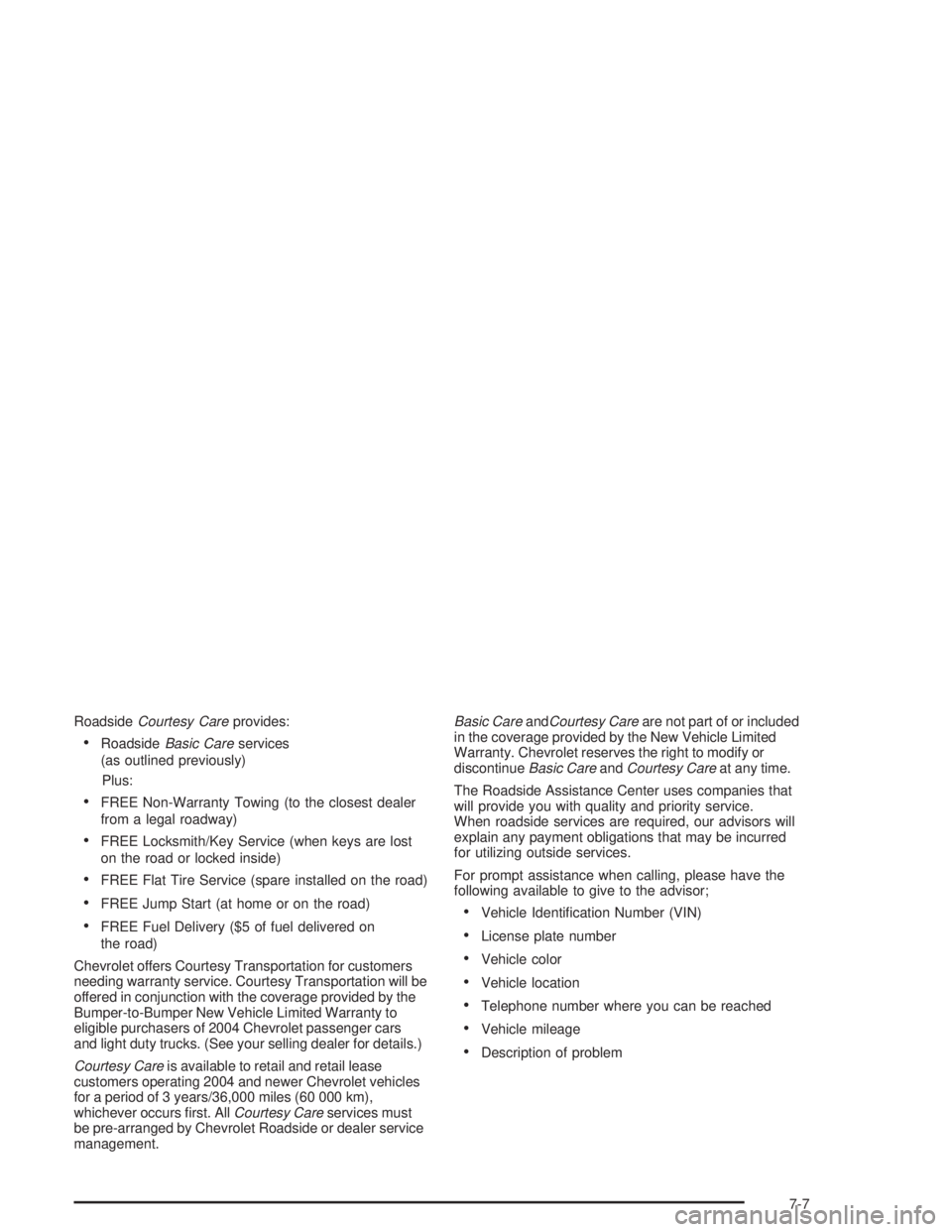
RoadsideCourtesy Careprovides:
RoadsideBasic Careservices
(as outlined previously)
Plus:
FREE Non-Warranty Towing (to the closest dealer
from a legal roadway)
FREE Locksmith/Key Service (when keys are lost
on the road or locked inside)
FREE Flat Tire Service (spare installed on the road)
FREE Jump Start (at home or on the road)
FREE Fuel Delivery ($5 of fuel delivered on
the road)
Chevrolet offers Courtesy Transportation for customers
needing warranty service. Courtesy Transportation will be
offered in conjunction with the coverage provided by the
Bumper-to-Bumper New Vehicle Limited Warranty to
eligible purchasers of 2004 Chevrolet passenger cars
and light duty trucks. (See your selling dealer for details.)
Courtesy Careis available to retail and retail lease
customers operating 2004 and newer Chevrolet vehicles
for a period of 3 years/36,000 miles (60 000 km),
whichever occurs �rst. AllCourtesy Careservices must
be pre-arranged by Chevrolet Roadside or dealer service
management.Basic CareandCourtesy Careare not part of or included
in the coverage provided by the New Vehicle Limited
Warranty. Chevrolet reserves the right to modify or
discontinueBasic CareandCourtesy Careat any time.
The Roadside Assistance Center uses companies that
will provide you with quality and priority service.
When roadside services are required, our advisors will
explain any payment obligations that may be incurred
for utilizing outside services.
For prompt assistance when calling, please have the
following available to give to the advisor;Vehicle Identi�cation Number (VIN)
License plate number
Vehicle color
Vehicle location
Telephone number where you can be reached
Vehicle mileage
Description of problem
7-7
Page 408 of 416
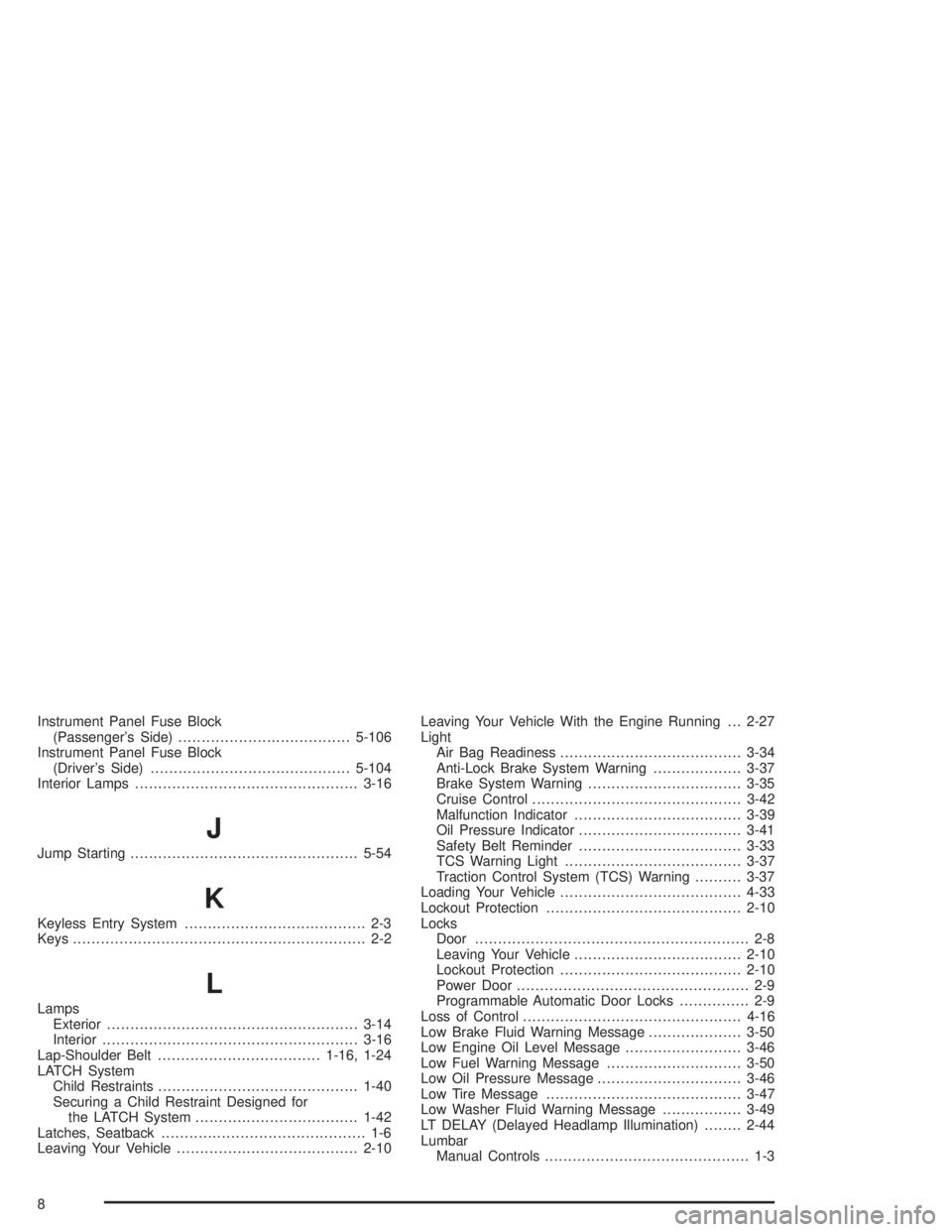
Instrument Panel Fuse Block
(Passenger’s Side).....................................5-106
Instrument Panel Fuse Block
(Driver’s Side)...........................................5-104
Interior Lamps................................................3-16
J
Jump Starting.................................................5-54
K
Keyless Entry System....................................... 2-3
Keys............................................................... 2-2
L
Lamps
Exterior......................................................3-14
Interior.......................................................3-16
Lap-Shoulder Belt...................................1-16, 1-24
LATCH System
Child Restraints...........................................1-40
Securing a Child Restraint Designed for
the LATCH System...................................1-42
Latches, Seatback............................................ 1-6
Leaving Your Vehicle.......................................2-10Leaving Your Vehicle With the Engine Running . . . 2-27
Light
Air Bag Readiness.......................................3-34
Anti-Lock Brake System Warning...................3-37
Brake System Warning.................................3-35
Cruise Control.............................................3-42
Malfunction Indicator....................................3-39
Oil Pressure Indicator...................................3-41
Safety Belt Reminder...................................3-33
TCS Warning Light......................................3-37
Traction Control System (TCS) Warning..........3-37
Loading Your Vehicle.......................................4-33
Lockout Protection..........................................2-10
Locks
Door........................................................... 2-8
Leaving Your Vehicle....................................2-10
Lockout Protection.......................................2-10
Power Door.................................................. 2-9
Programmable Automatic Door Locks............... 2-9
Loss of Control...............................................4-16
Low Brake Fluid Warning Message....................3-50
Low Engine Oil Level Message.........................3-46
Low Fuel Warning Message.............................3-50
Low Oil Pressure Message...............................3-46
Low Tire Message..........................................3-47
Low Washer Fluid Warning Message.................3-49
LT DELAY (Delayed Headlamp Illumination)........2-44
Lumbar
Manual Controls............................................ 1-3
8